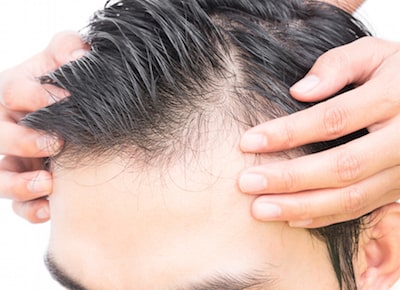Hair Transplant – What is it and how is it Performed?
When the phrase “hair transplant” is mentioned in conversation, some people instantly think of the pluggy and unnatural results that used to be visible to others. Hair transplant results have evolved greatly over the last few decades to the point that they are long lasting and natural in appearance. Our office often receives many questions about hair transplants and the length of time that the results last after a hair restoration procedure. Here is the important info all patients need to know regarding hair transplants.

What is a Hair Transplant?
A hair transplant is an outpatient procedure that is performed to move hair located in the donor area of the scalp (the back and sides of the head) to the areas of the scalp that are thinning or balding. If patients do not have enough quality donor hair on the scalp, donor hair can be taken from elsewhere on the body including the chest or beard.
Ideal patients are people that are experiencing a significant amount of thinning or balding on areas of their scalp. These patients want to restore the appearance of their hairline in order to get a youthful and full hairline.
The results of a hair transplant are considered to be permanent and the fact that a person had a hair restoration procedure is not detectable to others that are viewing the transplanted hair of the patient. It can take over a year for the final results to become visible.
The hair that comes from the donor area is resistant to balding so patients do not have to worry about the transplanted hair falling out of the scalp. There could be some instances of balding, in the future, in other areas of the scalp where hair was not transplanted during the surgery. Anyone that is experiencing additional balding can have another hair restoration procedure to address the balding in the other areas of the scalp.
Hair Transplant Procedures
Modern hair transplant techniques offer many options for patients and they include:
Follicular Unit Extraction/Excision (FUE) – The hair from the donor area is removed individually so it can be transplanted into the scalp. Since the hair grafts are individually harvested, there is not the appearance of a linear scalp scar after the surgery.
Power Hairline® – A hair transplant procedure for patients with a fading hairline that does not appear as robust as it was in the past. This technique gives increased density and strength to the hairline by transplanting a small number of hair grafts to the frontal 2-3cm of the hairline.
Celebrity Hair Transplant™ by Dr. Parsa Mohebi – A limited number of hair grafts are transplanted per session so the public will not be able to tell there was a hair transplant performed on the scalp. There is no need to shave the donor or recipient area and patients can wear the same hairstyle when they arrive and when they leave the office.
Beard to Scalp Hair Transplant – This hair restoration option is ideal for patients that have low quality donor hair, or not enough donor hair on the scalp, thanks to the high demand of their particular hair loss needs.
Follicular Unit Transplant (FUT) – The surgeon transplants the follicular units (in their natural grouping of one to four hair grafts) into the balding or thinning areas of the scalp. Since the follicular units are removed in their natural grouping, there will be a linear scar left on the scalp where the hair grafts were removed by the doctor.
Reasons for a Hair Transplant
 Beyond the obvious appearance of the balding or thinning areas of the scalp, there are other reasons patients want to have a hair transplant. They might feel like they look older without a full head of hair and want to restore the hair on the scalp to regain their youthful appearance.
Beyond the obvious appearance of the balding or thinning areas of the scalp, there are other reasons patients want to have a hair transplant. They might feel like they look older without a full head of hair and want to restore the hair on the scalp to regain their youthful appearance.
Patients might also want to undergo hair restoration in order to stay relevant in the business world. They want to keep their youthful appearance so they will be seen as “current” and in touch with the latest trends and information in the business world.
There are others that do not like their balding appearance and feel that it reflects poorly on them as a person. Their self-image is damaged by their balding scalp and they want to regain confidence in their appearance.
First Step in the Hair Transplant Process
If you are interested in undergoing a hair transplant, we invite you to schedule a consultation appointment at any of our medical surgical centers. Dr. Mohebi or Dr. G will discuss your desired results and also perform a thorough medical examination of your scalp. Once the reason for your hair loss is determined, our doctors will discuss your hair transplant options as well as the type of results you can realistically expect to see. Once you and the doctor are in agreement about the treatment plan, your hair transplant surgery can be scheduled.
MA